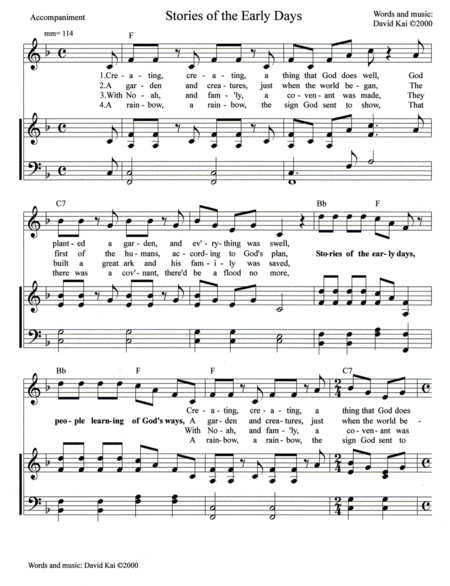Guitar,Piano,Vocal,Voice - Digital Download SKU: A0.893851 Composed by David Kai. Children,Christian,Sacred. Score. 3 pages. David Kai #5322227. Published by David Kai (A0.893851). This song teaches the stories from the first chapters of the book of Genesis.With the purchase of this music, you may make copies of the lead sheet or lyrics for your church school or choir. Please report any congregational use to One License or CCLI.Stories of the Early Days by David Kai ©2000 (with thanks and apologies to W.A. Mozart)1. Creating, creating, a thing that God does well, God planted a garden, and everything was swellStories of the early days, people learning of Godâs ways, Creating, creating, a thing that God does well.2. A garden and creatures, just when the world began, The first of the humans, according to Godâs plan,Stories of the early days, people learning of Godâs ways, A garden and creatures, just when the world began.3. With Noah, and famâly, a covenant was made, They built a great ark and his family was saved, Stories of the early days, people learning of Godâs ways, With Noah, and famâly, a covenant was made.4. A rainbow, a rainbow, the sign God sent to show, That there was a covânant, thereâd be a flood no more,Stories of the early days, people learning of Godâs ways, A rainbow, a rainbow, the sign God sent to show.5. Oh Abram and Sarai, went to the Promised Land, God changed both their names and God changed all of their plans.Stories of the early days, people learning of Godâs ways, Oh Abram and Sarai, went to the Promised Land.6. Oh Sarah, oh Sarah, though she was very old, Gave birth to her Isaac, just as she had been told,Stories of the early days, people learning of Godâs ways, Oh Sarah, oh Sarah, though she was very old.7. Rebecca, Rebecca, her well of kindness showed that she was the right one, and so she chose to go,Stories of the early days, people learning of Godâs ways, Rebecca, Rebecca, her well of kindness showed.8. Old Isaac, gave Jacob, the blessing that was saved for Esau, his brother, who then began to rage,Stories of the early days, people learning of Godâs ways, Old Isaac, gave Jacob, the blessing that was saved.9. Oh Jacob, and Esau, they met again at last, And all was forgiven, the feud was in the past,Stories of the early days, people learning of Godâs ways, Oh Jacob, and Esau, they met again at last.
